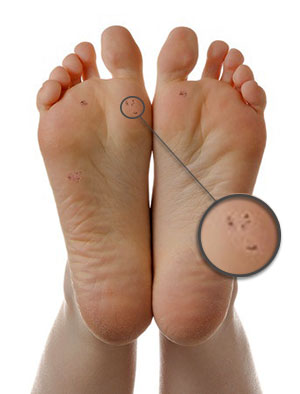
Standard chiropody treatment - £38 (or £49 for new clients)
You will be offered an appropriate treatment for your foot condition but if you require a specific type of treatment, please discuss this with your podiatrist during the initial consultation.
Our podiatrists can not offer treatments for warts elsewhere on the body (just your feet).
Please be aware that regular treatments may be required to achieve the best results, and you may require different types of treatment to remove your verrucae.
Verrucae are warts that can be found anywhere on the foot but commonly occur on the soles of the feet. They can even be found around the edges of toenails.
They are caused by the Human Papilloma Virus (HPV) and are passed from person to person by direct contact. The virus is thought to thrive in moist, damp environments such as swimming pools, changing room floors and communal shower areas. If an infected foot deposits skin cells onto the floor then it is possible to walk across the same floor and pick up the virus especially if your skin is cut or scratched.
They are harmless but in some circumstances they develop on a weight bearing area of the foot where they are likely to be painful. In these areas callus (hard skin) can also form over the top of the verruca, increasing the discomfort. Some strains of verrucae spread very quickly and can become unsightly.
They are most commonly seen in children, teenagers and young adults. Basically those who use communal changing rooms. In time, immunity may develop against the verruca virus but some people do remain more susceptible than others.
The classic appearance is cauliflower like, sometimes containing small black dots which are caused by small blood vessels leaking blood into the verruca. They can vary in size and numbers. An early stage verruca can look like a small, discoloured blemish on the skin, and be easily mistaken for a corn. Sometimes a verruca can quickly spread into a cluster made up of many tiny verrucae.
A simple diagnostic test is to pinch the skin (like you would squeeze a spot) where you think you may have a verruca. If it hurts, you may have a verruca. Corns tend not to hurt if you pinch them, but hurt if you press them. Pressing a verruca is generally painless. If you are still unsure before starting treatment, see a podiatrist or speak to your local pharmacist.
Evidence has shown that, in many cases, verrucae will disappear of their own accord within 2 years and therefore if it is painless no treatment is required. Sometimes treatment can increase the risk of cross infection, so that the verrucae spreads. The body’s defence mechanism, the immune system, will recognise the virus and fight the infection. Due to the nature of the virus, this may take many months to happen. Letting nature heal the verruca is the best and safest course of action. For painful, unsightly verrucae, or ones which are spreading, you may choose to self treat or seek professional help from a podiatrist.
Should you self treat, evidence has shown that ointments and gels containing salicylic acid are the most effective. Sometimes just by rubbing away the dry skin over the verruca and applying a plaster can stimulate the body’s immune system to fight the infection. Never self treat if you have diabetes, poor circulation, are pregnant or have any other conditions affecting the health of your feet. If you have diabetes, check with a podiatrist or your pharmacist before self treating.
The podiatrist will carry out an assessment of your general health as well as your foot health before deciding on a treatment plan. Important: there are risks associated with verrucae treatment and you must ensure you understand these before consenting to treatment. Adverse reactions are a possibility and the clinic can offer no compensation should you experience discomfort or infection following treatment, assuming that proper treatment protocols were followed.
Minimise your chances of catching verrucae by keeping your feet in a healthy condition. Use creams and lotions if your skin is dry and use surgical spirit if your feet are excessively sweaty. Treat other conditions such as Athlete’s foot, which can damage the skin surface. Wear flip-flops in communal changing areas and don’t share towels. Verruca socks can help avoid passing on the virus and also can be worn as a preventative measure.
This involves ointments or liquids containing acids, which are usually stronger than over the counter preparations, being applied to the verruca. These acids act by destroying the surface of the skin that the virus has infected. The podiatrist will apply the treatment to the skin at weekly or fortnightly intervals, after removing the overlying skin which the treatment has destroyed. Immediately after treatment the affected foot needs to be kept dry. You may be advised to soak the foot in a salt-water solution, but ensure that the foot is dried thoroughly afterwards and a suitable dressing applied.
This involves freezing the verruca with liquid nitrogen or nitrous oxide gas. This needs to be done at between 2 - 4 week intervals over a few months before the verruca is fully healed. However, it can lead to soreness and blistering in some people. You can still swim after this treatment, but it’s not advised for sensitive or anxious children.
Important: not all verrucae will respond to treatment. Some people may experience pain after treatment or develop further infection around the area. You must follow any after-care advice that is given by your podiatrist. You need to rest your foot as much as possible after treatment, as weight-bearing can aggravate the condition.
